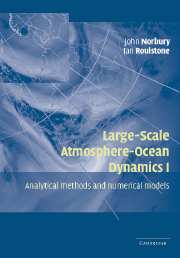Book contents
- Frontmatter
- Contents
- Contributors
- Preface
- Introduction and Scientific Background
- 1 A view of the equations of meteorological dynamics and various approximations
- 2 Extended-geostrophic Euler–Poincaré models for mesoscale oceanographic flow
- 3 Fast singular oscillating limits of stably-stratified 3D Euler and Navier–Stokes equations and ageostrophic wave fronts
- 4 New mathematical developments in atmosphere and ocean dynamics, and their application to computer simulations
- 5 Rearrangements of functions with applications to meteorology and ideal fluid flow
- 6 Statistical methods in atmospheric dynamics: probability metrics and discrepancy measures as a means of defining balance
Preface
Published online by Cambridge University Press: 04 February 2010
- Frontmatter
- Contents
- Contributors
- Preface
- Introduction and Scientific Background
- 1 A view of the equations of meteorological dynamics and various approximations
- 2 Extended-geostrophic Euler–Poincaré models for mesoscale oceanographic flow
- 3 Fast singular oscillating limits of stably-stratified 3D Euler and Navier–Stokes equations and ageostrophic wave fronts
- 4 New mathematical developments in atmosphere and ocean dynamics, and their application to computer simulations
- 5 Rearrangements of functions with applications to meteorology and ideal fluid flow
- 6 Statistical methods in atmospheric dynamics: probability metrics and discrepancy measures as a means of defining balance
Summary
These two volumes provide an up-to-date account of the mathematics and numerical modelling that underpins weather forecasting, climate change simulations, dynamical meteorology and oceanography. The articles are a combination of teaching/review material and present results from contemporary research. The subject matter will be of interest to mathematicians and meteorologists, from graduate students to experts in the field. The articles have been written with the intention of providing accessible, interdisciplinary, accounts. The Introduction, which appears in both volumes, provides a guide to, and a perspective on, the subject matter and contents, and draws some tentative conclusions about the possible directions for future research.
The volumes are the result of the stimulus provided by the programme on The Mathematics of Atmosphere and Ocean Dynamics held at the Isaac Newton Institute for Mathematical Sciences in 1996, together with a follow-up meeting there in December 1997. The mathematical, scientific and computational challenge behind weather forecasting is why should we be able to forecast at all when the dynamical equations, the heat/moisture processes, and the billions of arithmetical calculations on 10–100 million unknowns involved in global forecasting each have associated instabilities and the potential for chaos? The overarching idea was to identify the stabilising principles and represent them effectively in mathematics that would lead to successful and efficient computation. Certain geometrical ideas are found to characterise the essential controlling physical principles, and the interplay of geometry and analysis makes for interesting new mathematics and helps to explain why computation of useful information becomes possible in the presence of chaos.
Information
- Type
- Chapter
- Information
- Large-Scale Atmosphere-Ocean DynamicsAnalytical Methods and Numerical Models, pp. xi - xiiPublisher: Cambridge University PressPrint publication year: 2002
